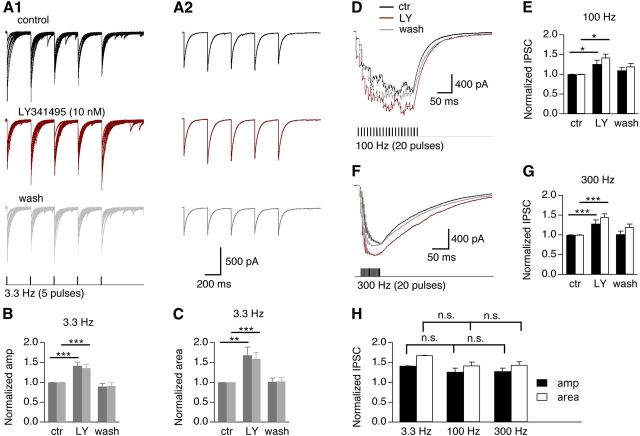Figure 8.
Synaptically released glutamate activates mGluR II independent of stimulus frequency. Train stimulations that caused concurrent activation of the glutamatergic and GABAergic pathways were used. A, Superimposed original current traces evoked by a train stimulation at 3.3 Hz (A1) and averaged IPSCs (A2) obtained under conditions of control, the mGluR II antagonist LY341495 (10 nm), and wash. A nearly complete recovery of the responses is observed after the washout. B, LY341495 (LY) significantly increases the normalized amplitude of IPSCs regardless of the presence of transmission failures (n = 9; dark gray: failures included, p < 0.001; light gray: failures excluded, p < 0.001). Post hoc Fisher's analyses revealed significant differences in normalized IPSC amplitude between control (ctr) and LY341495. C, Consistently, LY341495 also significantly increases the normalized area (representing charge) of IPSCs (n = 9; dark gray: failures included, p < 0.01; light gray: failures excluded, p < 0.001). D, E, LY341495 significantly increases the normalized amplitude (dark filled bars, p = 0.0116) and area (open bars, p < 0.05) of IPSCs elicited by train stimulation (100 Hz, 20 pulses) (n = 3). F, G, LY341495 significantly increases the normalized amplitude (dark solid bars, p < 0.0001) and area (open bars, p < 0.0001) of IPSCs elicited by train stimulation (300 Hz, 20 pulses; n = 7). H, No significant differences in the effects of LY341495 on the amplitude and area of IPSCs are detected under different stimulus frequencies. *p < 0.05, **p < 0.01, ***p < 0.001 (ANOVA post hoc Fisher's test).

